Blog & Latest Updates
Fly Fishing Articles
Insects by Common Name


July 4th getaway to a small stream
Looking to do something outdoors and asocial during July 4th of the year of Covid-19, I took my wife to a small stream full of feisty westslope cutthroat trout. Of course, being July 4th, there were a few people around the easy-to-access spots (i.e. places to drive and set up a cushy camp ten feet from the truck), but it was easy to walk past them and have a beautiful little stream to ourselves. I'm both baffled and grateful that so few people see the value in chasing little trout in pretty little streams.
Videos by Troutnut from Mystery Creek #249 in Washington
Cinygmula par mating flight
Starring: Mayfly Species Cinygmula par
It's remarkable what thick hatches, and especially spinner flights, can come from a species few anglers have ever heard of. The genus Cinygmula is thought to produce unremarkable spinner flights, but this one would certainly have gotten the trout going if it weren't happening just before dark on a small stream where there isn't a lot of nocturnal feeding.
StateWashington
LocationMystery Creek #249
Date ShotJul 4, 2020
Date AddedJul 12, 2020
AuthorTroutnut
CameraiPhone Xs
Photos by Troutnut from Mystery Creek #249 in Washington
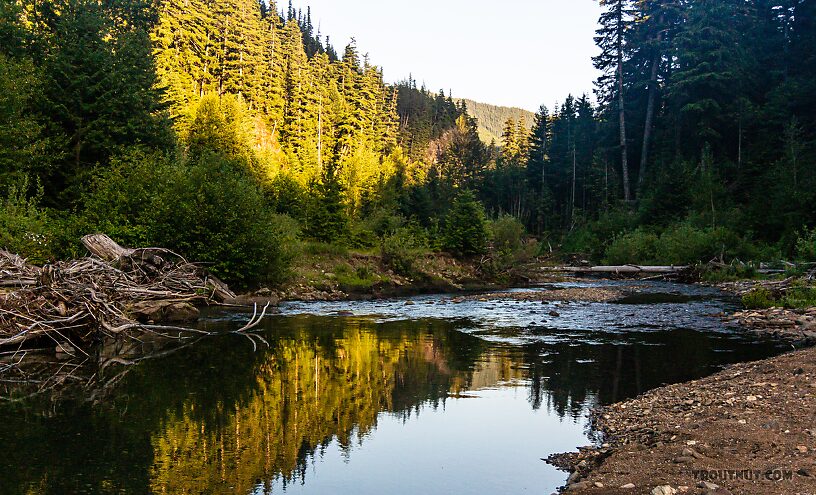
Closeup insects by Troutnut from Mystery Creek #249 in Washington
Drunella doddsii (Western Green Drake) Mayfly Nymph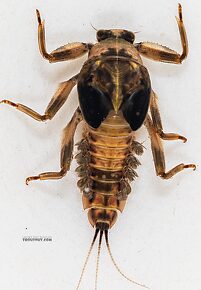 View 7 Pictures
View 7 Pictures
 View 7 Pictures
View 7 PicturesCollected July 4, 2020 from Mystery Creek #249 in Washington
Added to Troutnut.com by Troutnut on July 12, 2020
Added to Troutnut.com by Troutnut on July 12, 2020
Female Ephemerella excrucians (Pale Morning Dun) Mayfly Dun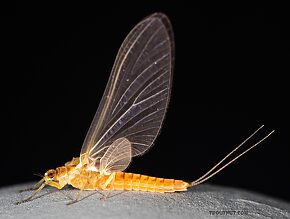 View 7 PicturesAlthough there is no key to female duns, I'm calling this dun Ephemerella excrucians because I collected several mature nymphs of that species on the same trip.
View 7 PicturesAlthough there is no key to female duns, I'm calling this dun Ephemerella excrucians because I collected several mature nymphs of that species on the same trip.
 View 7 PicturesAlthough there is no key to female duns, I'm calling this dun Ephemerella excrucians because I collected several mature nymphs of that species on the same trip.
View 7 PicturesAlthough there is no key to female duns, I'm calling this dun Ephemerella excrucians because I collected several mature nymphs of that species on the same trip.Collected July 4, 2020 from Mystery Creek #249 in Washington
Added to Troutnut.com by Troutnut on July 12, 2020
Added to Troutnut.com by Troutnut on July 12, 2020
Drunella grandis (Western Green Drake) Mayfly Nymph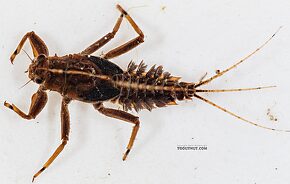 View 5 Pictures
View 5 Pictures
 View 5 Pictures
View 5 PicturesCollected July 4, 2020 from Mystery Creek #249 in Washington
Added to Troutnut.com by Troutnut on July 12, 2020
Added to Troutnut.com by Troutnut on July 12, 2020
Epeorus longimanus (Slate Brown Dun) Mayfly Nymph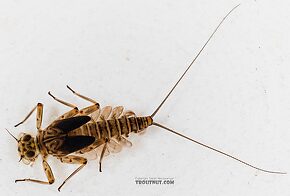 View 9 Pictures
View 9 Pictures
 View 9 Pictures
View 9 PicturesCollected July 4, 2020 from Mystery Creek #249 in Washington
Added to Troutnut.com by Troutnut on July 12, 2020
Added to Troutnut.com by Troutnut on July 12, 2020
Male Rhithrogena hageni (Western Black Quill) Mayfly Spinner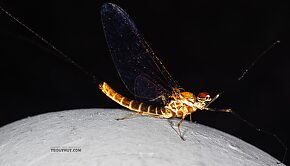 View 15 PicturesI collected this spinner from the trail (old logging road) above a whitewater canyon on a small stream in the Cascades. I'm fairly positive on the ID: in Traver 1935 it keys out to Rhithrogena doddsi, which is now a synonym (Synonym: A former name of a taxon, usually a species. Entomologists frequently discover that two insects originally described as different species are one in the same, and they drop one of the names. The dropped name is said to be a synonym of the remaining name. These changes take a while to trickle into the common knowledge of anglers; for example, Baetis vagans is now a synonym of Baetis tricaudatus.) of Rhithrogena hageni. The penes (Penes: The paired genital structures of most male insects, which vary widely in form and are one of the main characteristics used for species identification.) differ slightly from the drawing in that book, but they're a very close match to drawing from the original hageni description in Eaton 1885.
View 15 PicturesI collected this spinner from the trail (old logging road) above a whitewater canyon on a small stream in the Cascades. I'm fairly positive on the ID: in Traver 1935 it keys out to Rhithrogena doddsi, which is now a synonym (Synonym: A former name of a taxon, usually a species. Entomologists frequently discover that two insects originally described as different species are one in the same, and they drop one of the names. The dropped name is said to be a synonym of the remaining name. These changes take a while to trickle into the common knowledge of anglers; for example, Baetis vagans is now a synonym of Baetis tricaudatus.) of Rhithrogena hageni. The penes (Penes: The paired genital structures of most male insects, which vary widely in form and are one of the main characteristics used for species identification.) differ slightly from the drawing in that book, but they're a very close match to drawing from the original hageni description in Eaton 1885.
I'm using its ID to put a species ID on a female dun and mature nymph collected on the same trip. I'm also using this one's ID for a specimen with seemingly identical reproductive anatomy from Montana.
Lastly, I have included here a couple pictures of the genitalia of a different specimen collected on the same evening, from the same river, and I think even the same swarm (although I don't recall that 100 %). They're angled a bit differently, and I couldn't locate the mid-ventral (Ventral: Toward or on the bottom.) spines, but I'm guessing I'm just seeing intra-species variation.
 View 15 PicturesI collected this spinner from the trail (old logging road) above a whitewater canyon on a small stream in the Cascades. I'm fairly positive on the ID: in Traver 1935 it keys out to Rhithrogena doddsi, which is now a synonym (Synonym: A former name of a taxon, usually a species. Entomologists frequently discover that two insects originally described as different species are one in the same, and they drop one of the names. The dropped name is said to be a synonym of the remaining name. These changes take a while to trickle into the common knowledge of anglers; for example, Baetis vagans is now a synonym of Baetis tricaudatus.) of Rhithrogena hageni. The penes (Penes: The paired genital structures of most male insects, which vary widely in form and are one of the main characteristics used for species identification.) differ slightly from the drawing in that book, but they're a very close match to drawing from the original hageni description in Eaton 1885.
View 15 PicturesI collected this spinner from the trail (old logging road) above a whitewater canyon on a small stream in the Cascades. I'm fairly positive on the ID: in Traver 1935 it keys out to Rhithrogena doddsi, which is now a synonym (Synonym: A former name of a taxon, usually a species. Entomologists frequently discover that two insects originally described as different species are one in the same, and they drop one of the names. The dropped name is said to be a synonym of the remaining name. These changes take a while to trickle into the common knowledge of anglers; for example, Baetis vagans is now a synonym of Baetis tricaudatus.) of Rhithrogena hageni. The penes (Penes: The paired genital structures of most male insects, which vary widely in form and are one of the main characteristics used for species identification.) differ slightly from the drawing in that book, but they're a very close match to drawing from the original hageni description in Eaton 1885.I'm using its ID to put a species ID on a female dun and mature nymph collected on the same trip. I'm also using this one's ID for a specimen with seemingly identical reproductive anatomy from Montana.
Lastly, I have included here a couple pictures of the genitalia of a different specimen collected on the same evening, from the same river, and I think even the same swarm (although I don't recall that 100 %). They're angled a bit differently, and I couldn't locate the mid-ventral (Ventral: Toward or on the bottom.) spines, but I'm guessing I'm just seeing intra-species variation.
Collected July 4, 2020 from Mystery Creek #249 in Washington
Added to Troutnut.com by Troutnut on July 12, 2020
Added to Troutnut.com by Troutnut on July 12, 2020
Male Ephemerella excrucians (Pale Morning Dun) Mayfly Nymph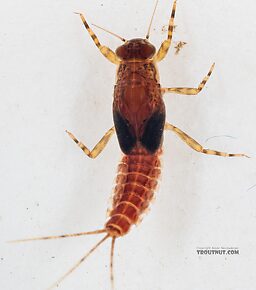 View 11 PicturesI used the ID of this nymph (and some others like it) to infer the identity of a female dun collected on the same trip.
View 11 PicturesI used the ID of this nymph (and some others like it) to infer the identity of a female dun collected on the same trip.
 View 11 PicturesI used the ID of this nymph (and some others like it) to infer the identity of a female dun collected on the same trip.
View 11 PicturesI used the ID of this nymph (and some others like it) to infer the identity of a female dun collected on the same trip.Collected July 4, 2020 from Mystery Creek #249 in Washington
Added to Troutnut.com by Troutnut on July 12, 2020
Added to Troutnut.com by Troutnut on July 12, 2020
Female Rhithrogena hageni (Western Black Quill) Mayfly Dun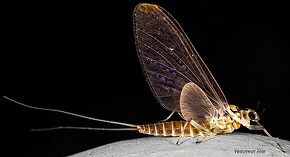 View 7 PicturesI was surprised by the olive cast on the body of this female Rhithrogena dun, which led me to mistake it for a western green drake (Drunella) in the field. I was pleasantly surprised to get a closer look and find something I hadn't collected yet. Its species ID is based on proximity to male spinner collected on the same trip, as well as physical similarity (size, tergite (
View 7 PicturesI was surprised by the olive cast on the body of this female Rhithrogena dun, which led me to mistake it for a western green drake (Drunella) in the field. I was pleasantly surprised to get a closer look and find something I hadn't collected yet. Its species ID is based on proximity to male spinner collected on the same trip, as well as physical similarity (size, tergite (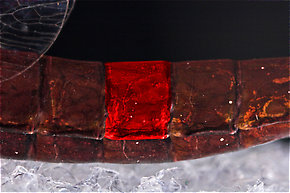 Tergite: The top (dorsal) part of a single segment on an insect's abdomen when it consists of a single chitinous plate (sclerite), or an individual sclerite if the segment has more than one.) coloration, dark streaks on the femora (
Tergite: The top (dorsal) part of a single segment on an insect's abdomen when it consists of a single chitinous plate (sclerite), or an individual sclerite if the segment has more than one.) coloration, dark streaks on the femora (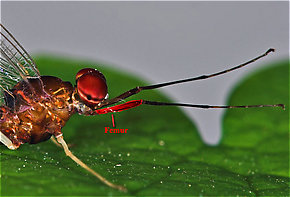 Femur: The main segment of an insect's leg close to the body, in between the tibia and the trochanter.)) to that specimen.
Femur: The main segment of an insect's leg close to the body, in between the tibia and the trochanter.)) to that specimen.
 View 7 PicturesI was surprised by the olive cast on the body of this female Rhithrogena dun, which led me to mistake it for a western green drake (Drunella) in the field. I was pleasantly surprised to get a closer look and find something I hadn't collected yet. Its species ID is based on proximity to male spinner collected on the same trip, as well as physical similarity (size, tergite (
View 7 PicturesI was surprised by the olive cast on the body of this female Rhithrogena dun, which led me to mistake it for a western green drake (Drunella) in the field. I was pleasantly surprised to get a closer look and find something I hadn't collected yet. Its species ID is based on proximity to male spinner collected on the same trip, as well as physical similarity (size, tergite (
One tergite of this Isonychia bicolor mayfly spinner is highlighted in red.

The femur of this Isonychia bicolor mayfly spinner is highlighted in red.
Collected July 4, 2020 from Mystery Creek #249 in Washington
Added to Troutnut.com by Troutnut on July 12, 2020
Added to Troutnut.com by Troutnut on July 12, 2020
Female Suwallia pallidula (Sallfly) Stonefly Adult View 6 PicturesI didn't key this one out under the microscope, but I just keyed a similar one from Montana and this one matches the macroscopic appearance closely enough that I'm guessing it's the same thing.
View 6 PicturesI didn't key this one out under the microscope, but I just keyed a similar one from Montana and this one matches the macroscopic appearance closely enough that I'm guessing it's the same thing.
 View 6 PicturesI didn't key this one out under the microscope, but I just keyed a similar one from Montana and this one matches the macroscopic appearance closely enough that I'm guessing it's the same thing.
View 6 PicturesI didn't key this one out under the microscope, but I just keyed a similar one from Montana and this one matches the macroscopic appearance closely enough that I'm guessing it's the same thing.Collected July 4, 2020 from Mystery Creek #249 in Washington
Added to Troutnut.com by Troutnut on July 12, 2020
Added to Troutnut.com by Troutnut on July 12, 2020
Male Cinygmula par Mayfly Spinner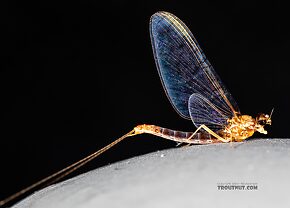 View 9 PicturesThis spinner came from one of those huge swarms that make one just stop fishing and admire the spectacle. Not bad for a little-known species.
View 9 PicturesThis spinner came from one of those huge swarms that make one just stop fishing and admire the spectacle. Not bad for a little-known species.
In the same swarm I collected a female and another male.
 View 9 PicturesThis spinner came from one of those huge swarms that make one just stop fishing and admire the spectacle. Not bad for a little-known species.
View 9 PicturesThis spinner came from one of those huge swarms that make one just stop fishing and admire the spectacle. Not bad for a little-known species.In the same swarm I collected a female and another male.
Collected July 4, 2020 from Mystery Creek #249 in Washington
Added to Troutnut.com by Troutnut on July 12, 2020
Added to Troutnut.com by Troutnut on July 12, 2020
Male Cinygmula par Mayfly Spinner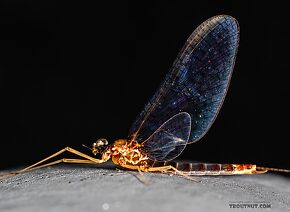 View 9 PicturesThis specimen was collected from a swarm with a female and another male.
View 9 PicturesThis specimen was collected from a swarm with a female and another male.
 View 9 PicturesThis specimen was collected from a swarm with a female and another male.
View 9 PicturesThis specimen was collected from a swarm with a female and another male.Collected July 4, 2020 from Mystery Creek #249 in Washington
Added to Troutnut.com by Troutnut on July 12, 2020
Added to Troutnut.com by Troutnut on July 12, 2020
Rhithrogena hageni (Western Black Quill) Mayfly Nymph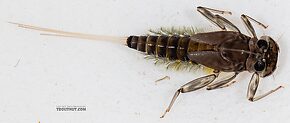 View 9 PicturesI'm basing the ID of this near-mature nymph on a male spinner with similar size and markings, collected on the same trip. There isn't a key to reliably identify the nymphs of most Rhithrogena species otherwise.
View 9 PicturesI'm basing the ID of this near-mature nymph on a male spinner with similar size and markings, collected on the same trip. There isn't a key to reliably identify the nymphs of most Rhithrogena species otherwise.
 View 9 PicturesI'm basing the ID of this near-mature nymph on a male spinner with similar size and markings, collected on the same trip. There isn't a key to reliably identify the nymphs of most Rhithrogena species otherwise.
View 9 PicturesI'm basing the ID of this near-mature nymph on a male spinner with similar size and markings, collected on the same trip. There isn't a key to reliably identify the nymphs of most Rhithrogena species otherwise.Collected July 4, 2020 from Mystery Creek #249 in Washington
Added to Troutnut.com by Troutnut on July 12, 2020
Added to Troutnut.com by Troutnut on July 12, 2020
Chironomidae (Midges) Midge Larva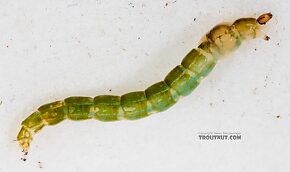 View 8 PicturesI don't see a lot of green Chironomidae larvae in my samples, so I photographed this one.
View 8 PicturesI don't see a lot of green Chironomidae larvae in my samples, so I photographed this one.
 View 8 PicturesI don't see a lot of green Chironomidae larvae in my samples, so I photographed this one.
View 8 PicturesI don't see a lot of green Chironomidae larvae in my samples, so I photographed this one.Collected July 4, 2020 from Mystery Creek #249 in Washington
Added to Troutnut.com by Troutnut on July 12, 2020
Added to Troutnut.com by Troutnut on July 12, 2020
Dolichopodidae True Fly Larva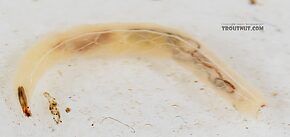 View 10 Pictures
View 10 Pictures
 View 10 Pictures
View 10 PicturesCollected July 4, 2020 from Mystery Creek #249 in Washington
Added to Troutnut.com by Troutnut on July 12, 2020
Added to Troutnut.com by Troutnut on July 12, 2020
Hexatoma True Fly Larva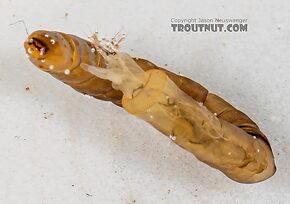 View 5 Pictures
View 5 Pictures
 View 5 Pictures
View 5 PicturesCollected July 4, 2020 from Mystery Creek #249 in Washington
Added to Troutnut.com by Troutnut on July 12, 2020
Added to Troutnut.com by Troutnut on July 12, 2020
Female Cinygmula par Mayfly Spinner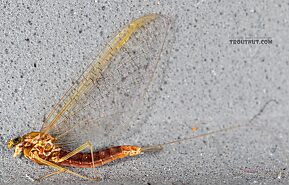 View 3 PicturesThis female spinner was captured in a swarm with this male and this other male, allowing for identification.
View 3 PicturesThis female spinner was captured in a swarm with this male and this other male, allowing for identification.
 View 3 PicturesThis female spinner was captured in a swarm with this male and this other male, allowing for identification.
View 3 PicturesThis female spinner was captured in a swarm with this male and this other male, allowing for identification.Collected July 4, 2020 from Mystery Creek #249 in Washington
Added to Troutnut.com by Troutnut on July 12, 2020
Added to Troutnut.com by Troutnut on July 12, 2020
«Older: Trip report from my Idaho mule deer hunt in 2019Newer: Quick bug stop on the Dosewallips River»
Most recent comments on this post (latest on top)
Comment on this post
Top 10 Fly Hatches
Top Gift Shop Designs
Eat mayflies.
Top Insect Specimens
Miscellaneous Sites
Troutnut.com is copyright © 2004-2024 Jason
Neuswanger (email Jason). See my FAQ for information about use of my images.
 privacy policy
privacy policy
